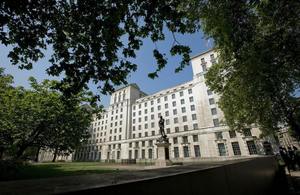RFA Fort George arrives in Plymouth for the final time
RFA Fort George, a support ship to the Royal Navy, has entered Plymouth for the final time before retiring from service after distinguished worldwide service.

The Royal Fleet Auxiliary (RFA) vessel arrived at Devonport Naval Base for the final time on Tuesday 1 February 2011, where it will unload cargo and equipment prior to the ship going out of service later in the year.
RFA Fort George has served with distinction throughout the world. Highlights include the handover of Hong Kong, playing a major part in the flood relief effort in Mozambique in 2000 for which the ship and her embarked squadron, 820 Naval Air Squadron, were awarded the Wilkinson Sword of Peace, and, in June of that year, supporting Operation PALLISER, the Sierra Leone campaign. In early 2002 the ship was heavily involved in Operation ORACLE, supporting the land forces in Afghanistan, and the highlight of 2004 was a high-profile visit to New York for the Independence Day celebrations, where the ship was given a prime berth in Manhattan next to the new Cunard liner, Queen Mary 2.
RFA Fort George Commanding Officer, Captain Jamie Murchie, said:
The auxiliary oiler replenishment class of RFA ships are the largest in the fleet, displacing more than HMS Ark Royal or HMS Ocean, and their flexibility and adaptability has brought them many varied tasks throughout the years.
The ship’s multi-role and flexibility has been the key to her success in humanitarian and operational tasks over the years.” For the Trafalgar 200 Fleet Review off Spithead in 2005 the ship acted as the host ship for the Royal Naval Reserve and hosted Their Royal Highnesses Prince and Princess Michael of Kent.
In 2010 RFA Fort George carried out the highest total of deck landings in the Royal Navy through the Auriga 2010 deployment in the US, two Joint Warrior exercises in the Atlantic off Scotland, and several periods of supporting operational flying training for squadrons from the Royal Navy’s Fleet Air Arm, Army and RAF.
Last year culminated with RFA Fort George winning the Royal Fleet Auxiliary ‘Ship of the Year’ category in the Commander-in-Chief’s ‘Surface Ship Effectiveness’ Trophy for the ship’s work supporting the Auriga 2010 deployment.
Captain Murchie said:
We have been preparing for this final entry day for some time now. It is a privilege to be here at the final moments of a ship’s life. For me especially I have brought two ships into service and now will have taken two ships out of service. I am proud to be the last Commanding Officer of RFA Fort George.
He said the ship’s final fate had yet to be determined, but one of his priorities would be to ensure the least disruption to the crew as they leave the ship in the following weeks. He said some had already left for training or been posted to other Royal Fleet Auxiliary ships and establishments. Captain Murchie said he was looking forward to hosting the ship’s sponsor Lady Annie Slater and her husband Admiral Sir Jock Slater at a farewell lunch onboard before the ship finally leaves Plymouth.
RFA Fort George was built by Swan Hunter Shipbuilders on the Tyne and entered service in 1994. The ship is being withdrawn from service under the Strategic Defence and Security Review and the need to reduce the number of auxiliaries required to support a reduced fleet.
The ship is one of two auxiliary oiler replenishment class ships - combined fleet support tanker and stores ships designed to give one-stop support to naval task groups.
RFA Fort George has a crew of 95 officers and ratings of the Royal Fleet Auxiliary, 24 members of the civilian Defence Equipment and Support organisation, and 15 Royal Navy personnel for close-in weapon systems maintenance.
When a helicopter squadron is embarked, up to a further 90 Royal Navy aircrew and support staff are carried onboard. The ship has a large two-spot flight deck with hangar and maintenance services for three Merlin-sized helicopters.
The helicopters can be used for anti-submarine and anti-surface warfare and troop-carrying, or for the transfer of stores and equipment as loads underslung from the helicopters.
The ship can carry over 10,000 tonnes of fuel, aviation fuel, lubricating oil and fresh water as well as over 6,000 items of naval stores, armaments, food and general stores for issue to other ships.